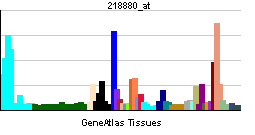FOSL2
| FOS-like antigen 2 | |||||||||||
|---|---|---|---|---|---|---|---|---|---|---|---|
| Identifiers | |||||||||||
| Symbols | FOSL2 ; FLJ23306; FRA2 | ||||||||||
| External IDs | Template:OMIM5 Template:MGI HomoloGene: 3845 | ||||||||||
| |||||||||||
| RNA expression pattern | |||||||||||
 | |||||||||||
 | |||||||||||
 | |||||||||||
| More reference expression data | |||||||||||
| Orthologs | |||||||||||
| Template:GNF Ortholog box | |||||||||||
| Species | Human | Mouse | |||||||||
| Entrez | n/a | n/a | |||||||||
| Ensembl | n/a | n/a | |||||||||
| UniProt | n/a | n/a | |||||||||
| RefSeq (mRNA) | n/a | n/a | |||||||||
| RefSeq (protein) | n/a | n/a | |||||||||
| Location (UCSC) | n/a | n/a | |||||||||
| PubMed search | n/a | n/a | |||||||||
FOS-like antigen 2, also known as FOSL2, is a human gene.[1]
The Fos gene family consists of 4 members: FOS, FOSB, FOSL1, and FOSL2. These genes encode leucine zipper proteins that can dimerize with proteins of the JUN family, thereby forming the transcription factor complex AP-1. As such, the FOS proteins have been implicated as regulators of cell proliferation, differentiation, and transformation.[1]
See also
References
Further reading
- Matsui M, Tokuhara M, Konuma Y; et al. (1990). "Isolation of human fos-related genes and their expression during monocyte-macrophage differentiation". Oncogene. 5 (3): 249–55. PMID 2107490.
- Molven A, Houge G, Berger R (1997). "Chromosomal assignment of the human gene encoding the Fos-related antigen-2 (FRA2) to chromosome 2p22-p23". Genomics. 38 (1): 72–5. doi:10.1006/geno.1996.0593. PMID 8954781.
- Outinen PA, Sood SK, Pfeifer SI; et al. (1999). "Homocysteine-induced endoplasmic reticulum stress and growth arrest leads to specific changes in gene expression in human vascular endothelial cells". Blood. 94 (3): 959–67. PMID 10419887.
- Miyamoto NG, Medberry PS, Hesselgesser J; et al. (2000). "Interleukin-1beta induction of the chemokine RANTES promoter in the human astrocytoma line CH235 requires both constitutive and inducible transcription factors". J. Neuroimmunol. 105 (1): 78–90. PMID 10713367.
- Ng DC, Shafaee S, Lee D, Bikle DD (2000). "Requirement of an AP-1 site in the calcium response region of the involucrin promoter". J. Biol. Chem. 275 (31): 24080–8. doi:10.1074/jbc.M002508200. PMID 10816578.
- Bamberger AM, Milde-Langosch K, Rössing E; et al. (2001). "Expression pattern of the AP-1 family in endometrial cancer: correlations with cell cycle regulators". J. Cancer Res. Clin. Oncol. 127 (9): 545–50. PMID 11570575.
- Udalova IA, Kwiatkowski D (2001). "Interaction of AP-1 with a cluster of NF-kappa B binding elements in the human TNF promoter region". Biochem. Biophys. Res. Commun. 289 (1): 25–33. doi:10.1006/bbrc.2001.5929. PMID 11708771.
- Benkoussa M, Brand C, Delmotte MH; et al. (2002). "Retinoic acid receptors inhibit AP1 activation by regulating extracellular signal-regulated kinase and CBP recruitment to an AP1-responsive promoter". Mol. Cell. Biol. 22 (13): 4522–34. PMID 12052862.
- Strausberg RL, Feingold EA, Grouse LH; et al. (2003). "Generation and initial analysis of more than 15,000 full-length human and mouse cDNA sequences". Proc. Natl. Acad. Sci. U.S.A. 99 (26): 16899–903. doi:10.1073/pnas.242603899. PMID 12477932.
- Santalucía T, Christmann M, Yacoub MH, Brand NJ (2004). "Hypertrophic agonists induce the binding of c-Fos to an AP-1 site in cardiac myocytes: implications for the expression of GLUT1". Cardiovasc. Res. 59 (3): 639–48. PMID 14499865.
- Ota T, Suzuki Y, Nishikawa T; et al. (2004). "Complete sequencing and characterization of 21,243 full-length human cDNAs". Nat. Genet. 36 (1): 40–5. doi:10.1038/ng1285. PMID 14702039.
- Beausoleil SA, Jedrychowski M, Schwartz D; et al. (2004). "Large-scale characterization of HeLa cell nuclear phosphoproteins". Proc. Natl. Acad. Sci. U.S.A. 101 (33): 12130–5. doi:10.1073/pnas.0404720101. PMID 15302935.
- Gerhard DS, Wagner L, Feingold EA; et al. (2004). "The status, quality, and expansion of the NIH full-length cDNA project: the Mammalian Gene Collection (MGC)". Genome Res. 14 (10B): 2121–7. doi:10.1101/gr.2596504. PMID 15489334.
- Rual JF, Venkatesan K, Hao T; et al. (2005). "Towards a proteome-scale map of the human protein-protein interaction network". Nature. 437 (7062): 1173–8. doi:10.1038/nature04209. PMID 16189514.
- Olsen JV, Blagoev B, Gnad F; et al. (2006). "Global, in vivo, and site-specific phosphorylation dynamics in signaling networks". Cell. 127 (3): 635–48. doi:10.1016/j.cell.2006.09.026. PMID 17081983.
External links
- FOSL2+protein,+human at the US National Library of Medicine Medical Subject Headings (MeSH)
This article incorporates text from the United States National Library of Medicine, which is in the public domain.
| This protein-related article is a stub. You can help Wikipedia by expanding it. |